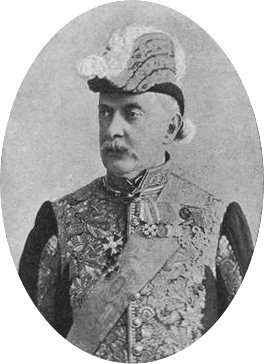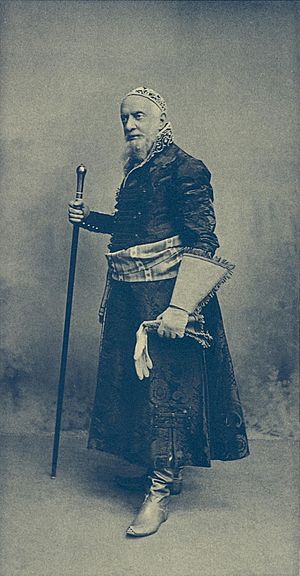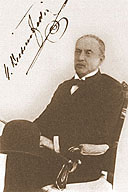Ivan Vsevolozhsky facts for kids
Ivan Alexandrovich Vsevolozhsky (Russian: Иван Александрович Всеволожский; 1835–1909) was a very important person in Russian theatre and art. From 1881 to 1898, he was the Director of the Imperial Theatres in Russia. After that, he became the director of the famous Hermitage Museum in 1899, a role he held until he passed away in 1909.
Vsevolozhsky was known for his strong desire for excellence in the Imperial Theatres. In 1886, he made two big changes for the theatres in Saint Petersburg. First, he moved the Imperial Ballet and Opera from the old Bolshoi Kamenny Theatre to the Mariinsky Theatre. The old theatre was considered unsafe. Second, he ended the job of 'First Imperial Ballet Composer'. People like Léon Minkus and Cesare Pugni used to hold this position. Experts like Alexandre Benois and Roland John Wiley say that Vsevolozhsky helped ballet become a serious art form in Russia again.
Contents
Early Life and Theatre Passion
Vsevolozhsky came from a very old and important family called Ryurik. His ancestors included princes from Smolensk. He studied at the University of St Petersburg. After university, he worked in international affairs, including at the Russian consulate in The Hague.
Even though he didn't have a background in managing theatres, Vsevolozhsky grew to love theatre. He also loved French culture. This happened while he worked at the Russian consulate in Paris starting in 1876. When Alexander III became Tsar, Vsevolozhsky was chosen to be the Director of Imperial Theatres in 1881.
Leading the Imperial Theatres
Vsevolozhsky was a new face in the theatre world, but he was very energetic and kind. He had amazing ideas. He was responsible for bringing to life world-famous ballets like The Sleeping Beauty and The Nutcracker. Both of these ballets had music by Pyotr Ilyich Tchaikovsky.
In 1888, he asked the Imperial Balletmaster Marius Petipa to create a full-length ballet based on the story of "Sleeping Beauty". This ballet would open at the Mariinsky Theatre. Vsevolozhsky successfully got the most famous Russian composer, Tchaikovsky, to write the music.
Vsevolozhsky himself wrote the story for the ballet, called the libretto. He had experience as a playwright (someone who writes plays) and an essayist (someone who writes essays). He was also a talented artist who could design costumes for the theatre. Because of his vision, The Sleeping Beauty ballet (1890) had the most expensive and detailed scenery and costumes ever seen at that time.
He was very busy sketching costumes. He made at least 1,087 drawings for 25 or more shows. This included the first productions of The Sleeping Beauty (1890) and The Nutcracker (1892).
Vsevolozhsky greatly admired Tchaikovsky's music. He played a key role in bringing three of Tchaikovsky's later operas to the stage. These were The Enchantress (1886), The Queen of Spades (1889), and Iolanta (1892). Iolanta was specifically asked for by Vsevolozhsky. It was meant to be the first part of a special evening. The second part was the ballet The Nutcracker.
The Nutcracker ballet was supposed to feature the choreography (dance steps) of Imperial Ballet Master Marius Petipa. However, Petipa was not well, so his assistant, Lev Ivanov, created the ballet instead. Iolanta and The Nutcracker premiered on December 6, 1892. They were somewhat successful, and Tchaikovsky thought they would be popular for "at least a couple of years."
As Director, Vsevolozhsky made many administrative changes. He created a committee to decide which shows to perform. He also raised salaries for artists and workers, some by a lot! Authors also got more money for their works. However, some of his ideas didn't work out as well. For example, he tried to stop giving away free tickets, which was not popular. He also increased the size of the orchestra. His reforms cost a lot more money than his predecessor, Baron Kister. Attempts to raise ticket prices were also widely disliked.
Working with Artists
Vsevolozhsky preferred French art, but his polite and friendly personality drew Tchaikovsky to work with him. He was one of Tchaikovsky's biggest supporters. This relationship was good for both of them. There was always a need for new music, and this pressure encouraged Tchaikovsky to create ballets again after his ballet Swan Lake wasn't very popular. Vsevolozhsky also made it easy for Tchaikovsky to work. Tchaikovsky's diary shows they had a close relationship. He wrote about rushing to Vsevolozhsky's house for important creative meetings that included Marius Petipa.
Vsevolozhsky also strongly supported Marius Petipa. They worked together on many successful productions like 'L'Ordre du roi', 'Les Ruses d'amour', and 'Sleeping Beauty'. These shows reminded people of the great age of French ballet. However, Vsevolozhsky's main goal was to promote Russian ballet. His critics sometimes complained about the lack of foreign dancers. He rarely went against his commitment to Russian art, as historian Roland John Wiley noted. This also matched the wishes of the Russian royal family. The Tsar had already stopped the Italian imperial opera to favor Russian opera before Vsevolozhsky's appointment. Vsevolozhsky was also expected to help Russian literature and culture.
Later Years
In 1899, Vsevolozhsky became the director of the Hermitage Museum, a very famous art museum. He stayed in this role until he died in 1909. He married Ekaterina Dmitrievna Volkonsky. She was the granddaughter of Field Marshall Prince P.M. Volkonsky (1776–1852). Prince Volkonsky had fought against Napoleon in the battle of Austerlitz under Tsar Alexander I.
Gallery
-
Marie Petipa (daughter of Marius Petipa) as the Lilac Fairy (costumed for Act II) in Vsevolozhsky's costume for the Petipa/Tchaikovsky The Sleeping Beauty (1890) -
Anna Johansson (daughter of Christian Johansson) as Canari qui Chante with two unidentified suitors in Vsevolozhsky's costumes for the Petipa/Tchaikovsky The Sleeping Beauty (1890) at the Mariinsky Theatre
See also
 In Spanish: Iván Vsévolozhsky para niños
In Spanish: Iván Vsévolozhsky para niños











